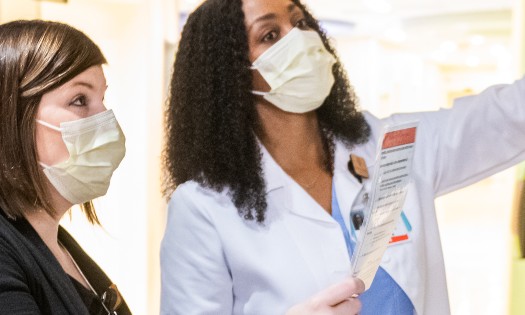In 2018, the pediatric dialysis center at Children’s Health℠, Children’s Medical Center Dallas embarked on a series of quality improvements to standardize care and improve outcomes for patients. These changes led to new protocols that improved care across our center and spawned a culture where each team member is empowered to voice concerns, identify potential improvements and recommend changes.
Our progress could be instructive for other centers and providers, as our team continually works toward better ways to improve the lives of children with end-stage renal disease.
“We’ve done everything from creating new protocols for dressing changes to adding a full-time clinical nurse specialist and a full-time nurse practitioner to the dialysis team,” says Diana Cardwell, APRN, who has played a key role in our improvement efforts. “These changes have raised the bar on how we care for more than 60 pediatric dialysis patients each year, and they reflect an environment where everyone on the team has a voice and is engaged in thinking critically about how we can get even better.”
Avoiding catheter infections in pediatric dialysis patients
Many improvements focused on preventing catheter infections. The consequences of infection are especially severe for children on hemodialysis, because of the catheter’s proximity to the heart and the speed at which bacteria can accelerate throughout the body.
“Very quickly, that infection can lead to sepsis,” says Rhyan Brown, APRN.
Even infections that are caught and treated can have lasting harm. After a catheter is removed to address the infection, the next catheter must usually be placed in a new vessel.
As Rhyan says, “A child has about six vessels available in that area — and they can’t afford to run out.”
A new approach to dressing changes
To reduce infections, our nephrology leaders partnered with the Children’s Health infection prevention team to review the literature and update practices for catheter management, particularly around dressing changes.
“Infections tend to arise from tiny margins of error rather than broad negligence, so we trained nurses on the nuances,” says Diana.
Our new standard of care includes massaging dressings for 15 seconds to fully activate the adhesive lining. Nurses used to change a dressing only at the end of a child’s dialysis visit, but now they inspect it right away and change it any time during the visit it appears necessary.
Nurses also standardized use of a protective skin barrier under the dressing. This helps keep the skin from getting irritated, so kids are less likely to itch and pick at the catheter site and open the skin to infection.
We used a collaborative, team approach to introduce changes. Our nurses learned and reviewed the new practices in daily huddles and staff development sessions. One of our nurse educators, Laken Haynie, trained and tested nurses on their skills, and our infection prevention team carried out audits. Laken also created new take-home instructions for patient families and retrained all current patients on how to properly clean and care for their catheters.
Today, Diana continues to audit and perform regular rounds to ensure the new practices are sustained. She created a dashboard to track the team’s performance and identify anyone who may need additional training.
“It’s been wonderful to see the dashboard’s status bars go from red to yellow to green as our staff normalizes all the changes,” Diana says.
Sparking a culture of improvement
At first, some staff members found the changes disruptive, and some worried about being punished for mistakes. But team leaders were positive and supportive when they coached and corrected staff. And they made it clear that feedback runs both ways: Nurses, technicians and others were encouraged to make observations and suggestions about where else the team could improve.
Our staff answered the call. For example, a nursing technician proposed using a new catheter cap called ClearGuard HD, which includes an antimicrobial filament to prevent infections. The cap is now standard throughout the nephrology wing.
Diana sees the new culture at play almost daily: “A nurse might tell a provider, ‘I notice this patient has a lot of fluid when they come in, maybe we should see them four times a week instead of three.’ Posing care recommendations to a superior like that didn’t happen two years ago.”
Knowing pediatric needs
The addition of Rhyan Brown, the nurse practitioner, has helped staff dramatically. With her on the floor, nurses have a provider to turn to for care decisions on days when the unit’s primary nephrologist is assigned to inpatient service or other commitments.
It also helps that Rhyan came to the center from the inpatient team, so she has experience with pediatric dialysis patients. Unlike adults, children on dialysis are usually being treated for kidney failure caused by congenital or neurological conditions, rather than lifestyle. Our nurses know to observe children from head to toe during their entire visit, because any sign of something “off” could indicate a serious health problem.
This expertise and teamwork were instrumental for a recent patient, who had an unusual reaction to a new dialysis prescription. His symptoms weren’t severe — a dry cough and slight drop in energy — but the nurse caring for him took the information to Rhyan anyway. She switched the child back to his original prescription and the symptoms improved.
The team ordered blood work, which revealed the child was anemic. Had they not acted when they did, the child could have fainted or suffered a cardiac event.
Recalls Rhyan, “All the changes we’ve made with staffing and attention to detail came together to keep that patient safe.”
Learn more about innovative nephrology care and research at Children’s Health
